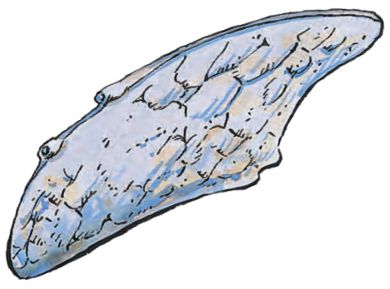

Monstrous Manual

| Lurker | Trapper | Trapper, Forest | |
|---|---|---|---|
| Rôde-dessus | Attrapeur | Attrapeur des bois | |
| Climate/Terrain: | Subterranean | Subterranean | Forest |
| Frequency: | Uncommon | Rare | Rare |
| Organization: | Solitary | Solitary | Solitary |
| Activity Cycle: | Any | Any | Any |
| Diet: | Omnivore | Carnivore | Carnivore |
| Intelligence: | Non- (0) | Highly (13-14) | Highly (13-14) |
| Treasure: | C,Y | G | G |
| Alignment: | Neutral | Neutral | Neutral |
| No. Appearing: | 1 (1-4) | 1 | 1 |
| Armor Class: | 6 | 3 | 4 |
| Movement: | 1, Fl 9 (B) | 3 | 3, Br 6 |
| Hit Dice: | 10 | 12 | 10 |
| THAC0: | 11 | 9 | 11 |
| No. of Attacks: | 1 | 4+ | See below |
| Damage/Attack: | 1-6 | See below | See below |
| Special Attacks: | See below | See below | See below |
| Special Defenses: | Nil | Nil | Nil |
| Magic Resistance: | Nil | Nil | Nil |
| Size: | H (20’ diam.) | H (20-30’ diam.) | H (20’ diam.) |
| Morale: | Steady (11) | Steady (11) | Steady (11) |
| XP Value: | 2,000 | 3,000 | 3,000 |
The lurker is a carnivorous scavenger found only in subterranean settings. It resembles a large manta ray; its grayish belly is textured like stone. The lurker typically attaches itself to a ceiling, where it is very difficult to detect (only 10% chance) unless actually prodded.
Combat: Lurkers are slow-moving creatures that must wait for their prey to come into range. Lurkers wait on the ceiling, then drop and wrap themselves around their prey. Lurkers cause a -4 penalty to opponents’ surprise rolls. The constriction causes 1d6 points of damage per round and suffocation within 1d4+1 rounds, regardless of the damage suffered by the victim. This damage is automatic each round unless the victim breaks free or the lurker dies. Lurkers do not stop attacking until dead. Prey can only fight with short weapons that were in hand when the lurker attacked.
Habitat/Society: Lurkers are solitary creatures. The females lays eggs in a glutinous clutch near the ceiling. The hatchlings fall to the ground and feed on vermin until they become large enough to fly. Young resemble rectangular patches of moss.
Ecology: Lurkers are opportunistic feeders that make do with whatever wanders by. The lurker flies by means of gases generated into sacs. These gases may be used in the preparation of a potion of levitation. Lurker eggs or hatchlings may be sold as living defenses for those who want them. Lurker, trapper, and miner eggs can all be sold for 900 gp, hatchlings for 1,100 gp.
The subterranean trapper is found only in caves and other dark places. It can alter its shape and color to resemble the local floor and to form a protuberance in the center that resembles a box. A trapper is difficult to detect (95%) once it has settled into a disguise. When prey wanders into the trapper’s center, the creature’s edges rise up and wrap around the victim. The victim suffers damage per round equal to 4 points plus his Armor Class (a victim with AC 2 suffers 6 points of damage per round). The constriction prevents breathing; victims smother in six rounds regardless of the damage suffered. A trapper does not release a victim unless the trapper is reduced to 1 hit point or killed.
Trappers are immune to heat- or cold-based attacks. Trappers remain wrapped in a ball for 1d8 hours while digesting a victim. The remains of their victims are excreted below and form the trappers’ treasure troves. A typical trapper can cover about 400 square feet, while large ones can cover up to 600 square feet.
Eggs are laid in a pebble-like mass. Hatchlings resemble flat rocks. Trapper skin may be used to make nonmagical +1 leather armor.
The forest trapper, or miner, resembles a tailless manta ray mottled brown or green-brown. Its frontal and dorsal ridges are hard bone.
It preys primarily on small forest animals but traps larger creatures by burrowing beneath paths or roads, then extending the 1d20+5 poisonous, twig-like barbs on its back through the surface. Passers-by have a 25% chance (75% if surprised) of unknowingly stepping on one. If not surprised, druids or rangers have a 5% chance per level of spotting and identifying the barbs. Victims must roll successful saving throws vs. poison or be paralyzed for 2d20 turns. A miner will not surface until all surface movement stops. Then it attacks in the same manner as a subterranean trapper.
Miners travel slowly on the surface by rippling like a snake. Burrowing is faster but travel is limited to soil, sand, and gravel.
Because a miner is always underground unless attacking, it is rarely attacked. The miner’s toxin is located in sacs at the base of the barbs. The toxic barbs can be used in a blowgun or as a hand weapon by small creatures, provided the grip is wrapped.
Eggs are laid in a clutch several feet below the surface. The young feed on burrowing animals for their first year.
